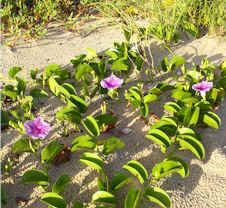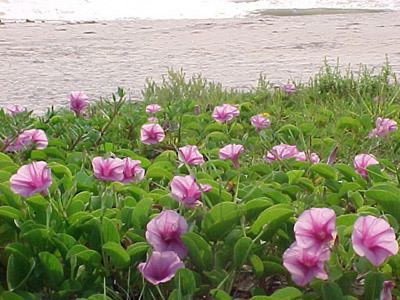Subgenus Eriospermum Higher classification Ipomoea | Genus Ipomoea Section Erpipomoea Rank Species | |
 | ||
Similar Ipomoea, Convolvulaceae, Ipomoea cairica, Tropical white morning‑glory, Scaevola taccada | ||
Ipomoea pes caprae linn at pakmeng beach trang thailand photo by piyarat chitaksorn
Ipomoea pes-caprae, also known as bayhops, beach morning glory or goat's foot, is a common pantropical creeping vine belonging to the family Convolvulaceae. It grows on the upper parts of beaches and endures salted air. It is one of the most common and most widely distributed salt tolerant plants and provides one of the best known examples of oceanic dispersal. Its seeds float and are unaffected by salt water.
Contents
- Ipomoea pes caprae linn at pakmeng beach trang thailand photo by piyarat chitaksorn
- How to germinate ipomoea pes caprae
- Distribution
- Uses
- References

Originally described by Linnaeus, it was placed in its current genus by Robert Brown in 1818.
How to germinate ipomoea pes caprae
Distribution

This species can be found on the sandy shores of the tropical Atlantic, Pacific, and Indian Oceans. Goat's Foot is common on the sand dunes of Australia's upper north coast of New South Wales, and can also be found along the entire Queensland coastline.

Goat's Foot is a primary sand stabilizer, being one of the first plants to colonise the dune. It grows on almost all parts of the dune but is usually found on the seaward slopes, sending long runners down towards the toe of the dune. The sprawling runners spread out from the woody rootstock, but the large two-lobed leaves are sparse and a dense cover on the sand is rarely achieved except in protected situations. This plant grows in association with sand spinifex grass and is a useful sand binder, thriving under conditions of sand blast and salt spray.
Community species: Ipomoea pes-caprae has been observed in community situations, studied for their endurance of difficult growing conditions (on dunes) with some other tough species.

Together with Melanthera biflora, Portulaca oleracea and Digitaria ciliaris, Ipomoea pes-caprae is usually one of the first species colonizing degraded or altered environments in tropical zones of the planet.
Uses
In Australia, it is a commonly used aboriginal medicine used as poultice for sting ray and stone fish stings.
In Brazil, this plant – namely the subspecies brasiliensis – is known as salsa-da-praia in folk medicine, and is used to treat inflammation and gastrointestinal disorders.
In the Philippines, the plant is known locally as Bagasua and is used to treat rheumatism, colic, oedema, whitlow, and piles.
